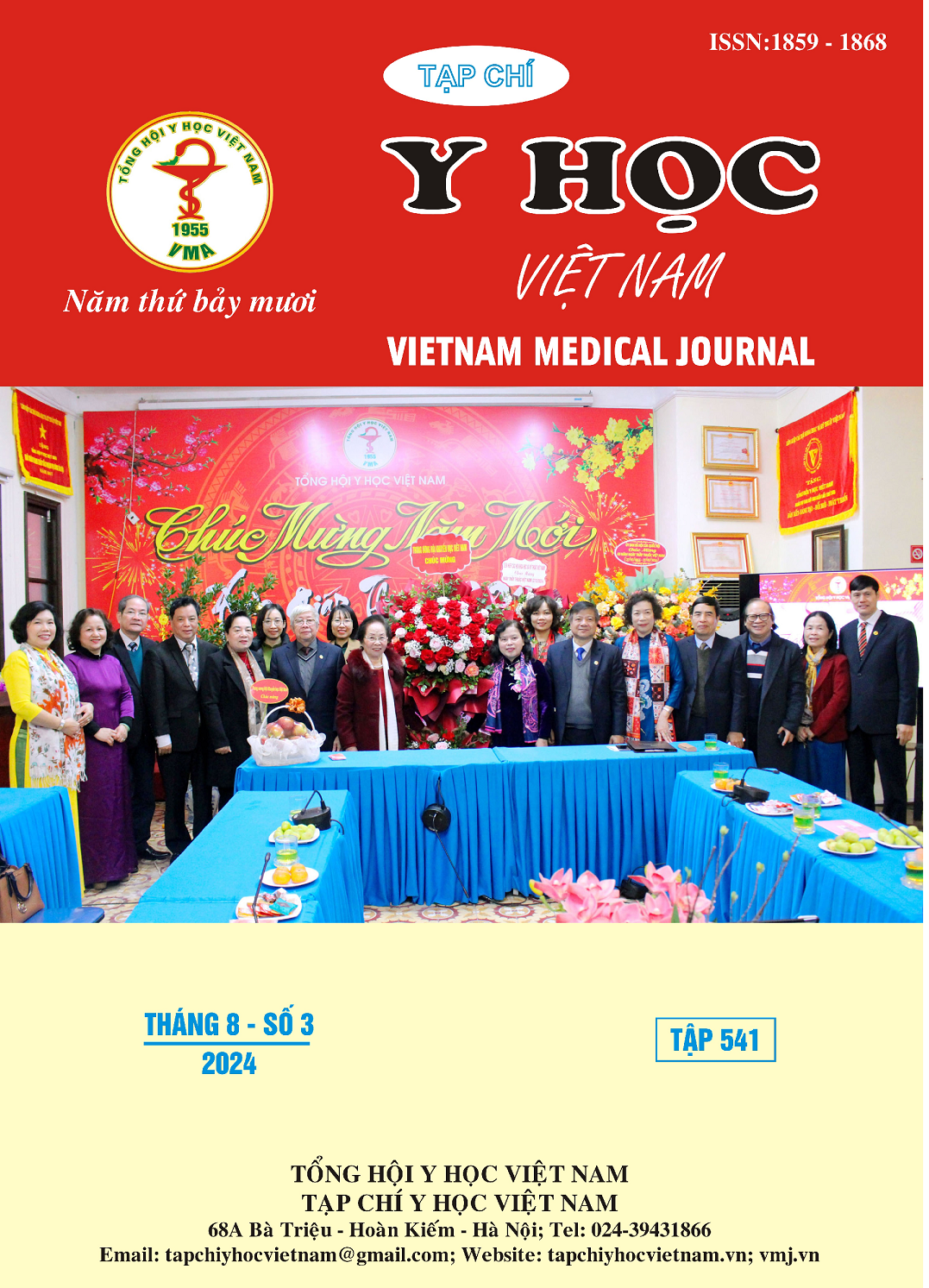ASSESSMENT THE RESULTS OF DYSPHAGIA TREATMENT IN PATIENTS WITH DAMAGED BRAIN AT THE NATIONAL REHABILITATION HOSPITAL
Main Article Content
Abstract
Objectives: To describe the clinical signals and evalutate the result of swallowing disolder treatment in the patients with damaged brain at the National Rehabilitation Hospital between August of 2023 and March of 2024. Materials and Methods: Intervention study comparing before and after treatment was conducted on 57 damaged brain patients with dysphagia, including 46 stroke and 11 traumatic brain injury patients at the National Rehabilitation Hospital. All of patients were treated with laryngopharyngeal neuromuscular electrical stimulation combined with traditional dysphagia therapies such as Masako, Shaker, Mendelsohn, thermal tactile oral stimulation, supraglottic swallow, effortful swallow and compensatory postural techniques. Fiberoptic endoscopic evaluation of swallowing (FEES) was used to evaluate patients before treatment, after 2 weeks and after 4 weeks of treatment using the Fiberoptic Endoscopic Dysphagia Severity Scale (FEDSS). Results: Before treatment, the distribution of FEDSS was as follows: 14% scored 6; 17,5% scored 5; 24,6% scored 4; 12,3% scored 3; and 31,6% scored 2. This indicates that 31,5% had severe dysphagia, 24.6% had moderate dysphagia, and 43,9% had mild dysphagia. The main symptoms observed during FEES were: 35,1% loss of sensation in laryngopharyngeal; 89,5% premature thin liquid; 64,9% premature pureed food; 45,6% premature solid food; 45,6% delayed onset of swallowing; 80,7% aspiration of thin liquid; 57,9% aspiration of pureed food; 33,3% aspiration of solid food; residue after swallowing ranged from 52,6% to 78,9%. After 4 weeks of treatment, the results were as follows: 21,2% had severe dysphagia, 15,8% had moderate dysphagia, 19,3% had mild dysphagia and 43,9% were normal. Significant improvements were observed in the following symptoms: loss of sensation in the laryngopharygeal; residue of secretion; delayed onset of swallowing, residue and aspiration of pureed food; premature, delayed onset of swallowing, residue and aspiration of thin liquid; difficulty in producing a bolus, delayed onset of swallowing and aspiration of soft solid food. Conclusion: Laryngopharyngeal neuromuscular electrical stimulation, in conjunction with swallowing exercises has been shown to be effective in treating dysphagia in patients with damaged brains. However, some severe dysphagia patients still require permanent feeding tube placement.
Article Details
Keywords
ischemia stroke, demaged brain, dysphagia/ swallowing disorder, FEES/ fiberoptic endoscopic evaluation of swallowing, laryngopharyngeal neuromuscular electrical stimulation, swallowing exercises, FEDSS.
References
2. Nguyễn Thị Vân, Phạm Văn Minh (2021). Đánh giá kết quả điều trị rối loạn nuốt ở người bệnh nhồi máu não bằng các bài tập nuốt kết hợp chất làm đặc thức ăn. Luận văn chuyên khoa II. Đại học Y Hà Nội
3. Bennion CM, Helliwell K, Hughes VJ, Manning-Stanley A. The use of videofluoroscopy (VFS) and fibreoptic endoscopic evaluation of swallowing (FEES) in the investigation of oropharyngeal dysphagia in stroke patients: A narrative review. Radiogr Lond Engl 1995. 2023;29(2):284-290.
4. Dziewas R, Michou E, Trapl-Grundschober M, et al. European Stroke Organisation and European Society for Swallowing Disorders guideline for the diagnosis and treatment of post-stroke dysphagia. Eur Stroke J. 2021;6(3):LXXXIX-CXV.
5. Ebru K. Umay, Atilay Yaylaci (2017). The effect of sensory level electrical stimulation of the masseter muscle in early stroke patients with dysphagia: A randomized controlled study - PubMed
6. González-Fernández M, Ottenstein L, Atanelov L, Christian AB. Dysphagia after Stroke: an Overview. Curr Phys Med Rehabil Rep. 2013;1(3):187-196.
7. Langmore SE. History of Fiberoptic Endoscopic Evaluation of Swallowing for Evaluation and Management of Pharyngeal Dysphagia: Changes over the Years. Dysphagia. 2017;32(1):27-38.
8. Warnecke T, Teismann I, Oelenberg S, et al. Towards a basic endoscopic evaluation of swallowing in acute stroke - identification of salient findings by the inexperienced examiner. BMC Med Educ. 2009;9:13.


